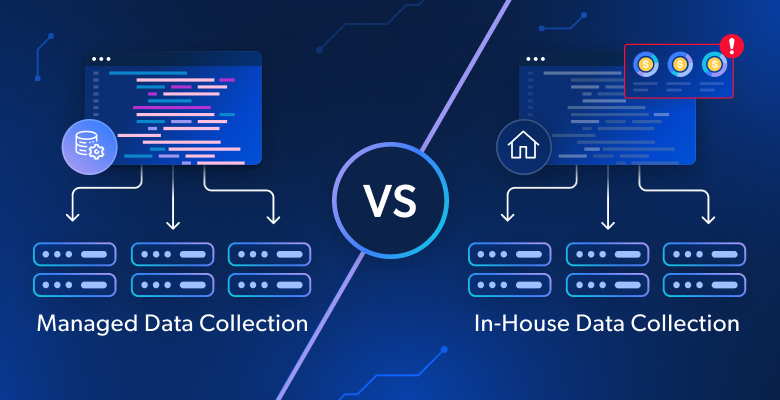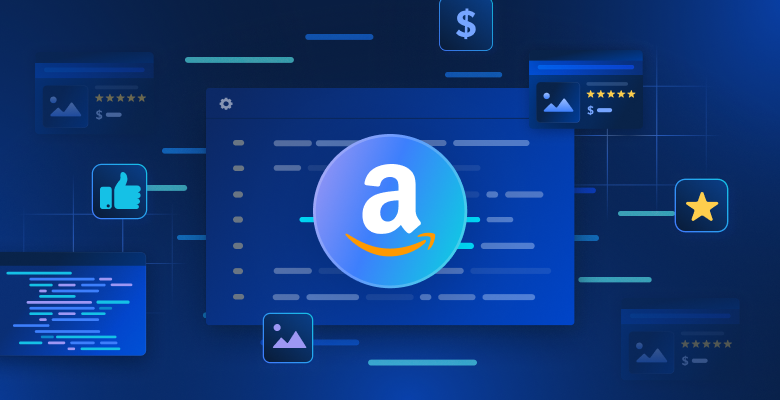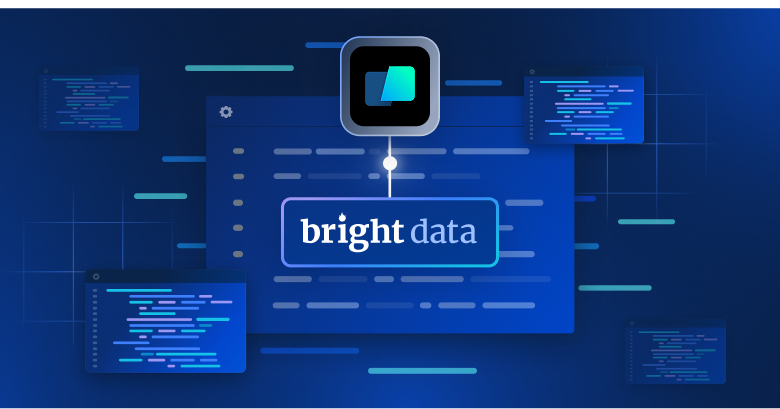Modern companies rely on data to drive decisions. The public web is one of the largest and freshest sources of that data. Product pages, prices, reviews, job listings, news, and forums update constantly and reflect real market behavior. Collected responsibly, web data gives teams a live view of customers, competitors, and trends. This is why e-commerce platforms track competitor pricing, travel sites monitor airline rates, and financial services companies follow real-time market data. For AI-driven companies, data is especially important as they rely on it for most of their operations.
But before organizations can use web data, they have to decide how they want to collect it. There are two options: build collection capabilities in-house or adopt a managed solution.
In-house solutions can take different approaches: you can handle everything internally, from infrastructure to scraper maintenance, for complete control over your scraping operations, or you can use external services while maintaining a dedicated internal team to manage the scraping process. Managed solutions involve partnering with specialized vendors who handle the entire data collection pipeline.
The decision between in-house scraping operations and a managed solution has major implications for time-to-market, data quality, scalability, compliance, and long-term maintenance. It’s not just a budgetary decision; it’s a strategic one. The wrong approach can slow your time-to-market, create compliance risks, or dilute data quality. In this article, you’ll learn about these two data collection approaches and how to evaluate their trade-offs.
How In-house Data Collection Works
In-house data collection requires your organization to build its own internal team and acquire the tools needed to collect data. The company must hire employees in various roles (eg data engineers, data scientists or data analysts). It also has to obtain different software tools and hardware, such as servers, cloud compute instances, storage solutions, like Amazon Simple Storage Service (Amazon S3), and workflow orchestration tools, like Apache Airflow. Once that’s taken care of, the internal team has to build and maintain the necessary infrastructure for data collection, which involves numerous different tasks:
- Develop and maintain scrapers and scripts that extract data, often leveraging tools like Python, Scrapy, Puppeteer and Selenium. This isn’t an easy task, particularly because every website has its own structure.
- Find solutions to bypass anti-scraping mechanisms, often using tools like proxies or CAPTCHA solvers.
- Monitor scrapers as they break quite often, usually as a result of changes in the target website.
- Ensure that the scraping practices are compliant and aren’t violating any regulations.
How Managed Data Collection Works
With managed data collection, all the operational challenges of in-house data collection become someone else’s responsibility. You simply describe your needs to an external partner, and they deliver clean, formatted data that’s ready to use. This frees your employees to focus on data analysis and product development rather than spending time on web scraping. The external team develops and maintains the scrapers, deals with any potential anti-scraping mechanisms, monitors the scrapers and ensures compliance.
Think of a managed data collection approach as a fully serviced office. As soon as you come in, everything is ready and prepared for you to start working. You don’t need to know how everything got there. If something breaks, you don’t need to worry about it; someone else fixes it. In contrast, in-house data collection is akin to building your own office from scratch. You have to take care of everything, and you’re responsible if anything breaks.
In-house vs. Managed Data Collection
The decision between in-house and managed data collection is an important one. It determines how your organization collects and deals with web data and has a direct effect on the resources your company spends and its responsibilities.
When Building In-house Data Collection Makes Sense
Between in-house and managed data collection, neither approach is universally better.
One of the main advantages of in-house data collection is the control the organization has over the entire process, as well as the deep customization options. This is particularly valuable when data needs are extremely dynamic, or require complex extraction logic. Another use case for in-house is if you already have a skilled team and IT resources to build, maintain, and scale custom scraping.
In-house data collection is also helpful for organizations with strict compliance and regulatory requirements. Industries such as healthcare handle highly sensitive data, and regulations may require that data collection stay within the organization.
For example, consider a healthcare startup that handles sensitive patient-related records. Such records fall under the Health Insurance Portability and Accountability Act (HIPAA) regulations, which require strict control over who can access the patient data. Because of these regulations, the healthcare startup can’t use a third-party data collection vendor unless that vendor is HIPAA compliant and is willing to sign a Business Associate Agreement (BAA). In practice, many such startups choose to build their own in-house team.
Why Managed Data Collection Is Outsprinting the Competition
While there are some use cases when in-house data collection makes sense, in the majority of cases, outsourcing is the best choice.
Affordable and predictable
Although managed data collection isn’t always the cheapest option for small, one‑off jobs. It becomes cost‑effective when you need large volumes from many websites and ongoing maintenance as sites change.
With managed services, costs are predictable and easy to control: transparent pricing and proactive monitoring and fixes included, and fewer surprise expenses (infrastructure, re‑runs, overtime). You also get centralized governance and reporting to track spend.
Beyond infrastructure and expertise, managed vendors synchronize and normalize the data for you, merging multiple sources, cleaning/deduplicating, and delivering it in a ready‑to‑use format.
Easy to Scale
External data collection vendors make scaling easier. You can go from a few daily requests to millions by simply adjusting your data request. You don’t have to deal with servers, proxies, writing scrapers, or IP blockages since all that is taken care of by the vendor. Managed data collection is also faster to launch since you don’t have to build an in-house team.
Consider a fast-moving fintech company where speed is paramount. Building an in-house data team internally probably takes months. Managed data collection can accelerate data collection and help the company launch products faster.
Continuous Support and Service
Another huge advantage of managed data collection is the continuous support and service you can rely on. Companies that offer managed data collection don’t just set the scrapers up; they also continuously maintain them. This is incredibly important since scrapers break all the time and need constant updates. Data collection needs dedicated teams that monitor the entire process, identify errors and fix them.
Built-in Global Compliance
The process of data collection is regulated by laws, such as the General Data Protection Regulation (GDPR) and California Consumer Privacy Act (CCPA). Such regulations add another layer of complexity to the process.
Managed data collection ensures built-in global compliance. It has the compliance frameworks figured out, complete with logging and audit support.
Keep in mind that while vendors supply the compliance tools, in the end, the ultimate responsibility for compliance remains with the client.
How to Choose the Right Data Collection Method
How do you actually choose which method of data collection is right for your use case? The answer is not straightforward, and there are numerous factors to consider.
Time and Scalability Constraints
Time is one of the most important factors to consider. If you have months to build, an in-house team is an option. However, if speed and time to launch are important, managed data collection is the better choice.
The same is true for scalability. In-house data collection is not always flexible enough to handle growing volumes and increasing complexity, while scaling with managed data collection is straightforward.
Internal Expertise
You should also consider the expertise you already have in your organization. If there are already developers who have the skills necessary for data collection, in-house data collection is an option. This is particularly true for more mature companies as, with time, they develop stronger internal capabilities.
However, if there’s no internal expertise in your organization, you’d have to hire experts and build from scratch, which is a complex process. Managed data collection provides you with instant expertise.
Regulatory and Compliance Needs
Regulatory needs are another factor to consider. Certain industries are heavily regulated; managed data collection vendors provide built-in compliance frameworks.
However, in-house data collection can be better in this regard as it offers higher control over the process.
Comparison Table
| In-house Data Collection | Managed Data Collection | |
|---|---|---|
| Speed | Very slow to set up | Very fast to set up |
| Scaling | Complicated | Straightforward |
| Quality | Depends on the team | Usually high and consistently reliable |
| Compliance Risk | All risk is shouldered by the organization itself | Some risk is assumed by the data collection provider, although the client retains legal accountability |
| Team Focus | Large focus on data collection | All focus is on the core product |
| Cost | Very high upfront cost | Low upfront cost, scales with usage |
Conclusion
There are two main approaches to data collection: in-house and a managed solution. In an in-house approach, the organization builds its own team and infrastructure to collect data, giving it more control over the process, which is particularly important in heavily regulated industries. With managed data collection, the data collection process is outsourced to an external team, which is often more cost-effective, faster and easier to scale.
If you’re currently performing data collection in-house, you may want to consider whether managed data collection improves the process. The Bright Data managed data acquisition service allows you to get the data you need while avoiding all the costs and effort required to collect it. All you need to do is define the data sources you need, and Bright Data collects the data, refines, validates and enriches it. Your data and insights are then delivered to you, helping drive data-driven decisions.
Start a consultation call today or check out this Build vs. Buy worksheet, which can help you think through which approach is right for you.







